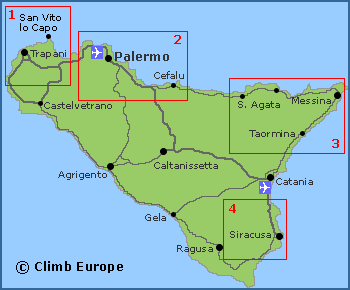Rock Climbing in Sicily
Rock climbing in Sicily offers everything from big wall multi-pitch rock climbing to single pitch sports routes, with the added bonus of visiting an island steeped thousands of years of civilization and culture. The rock climbing here offers a great sense of adventure and there is a warmth and hospitality from the islands population that is always willing to help tourists and foreigners. The rock climbing on Sicily is generally found along the northern and eastern coastlines, and can be broken down into 4 main areas:
Map of the main rock climbing areas of Sicily

2 – Palermo Rock Climbing Area
3 – Messina Rock Climbing Area
In the northeast side of Sicily the rock climbing around Messina consists of 11 separate limestone crag. Here there is a combination of sea cliffs and multi-pitch bolted routes up to 150m long. The largest crag is at Castelmola, near Taormina, which offers nearly 80 single pitch sport routes across a good selection of grades.
The Di Roccia di Sole - Crags is the only guidebook covering the sport climbing around Messina.
4 – Siracusa – Ragusa Rock Climbing Area
Siracusa is the 3rd largest climbing area in Sicily that is situated around the Monti Iblei plateau. The main climbing area is called Canicattini that has many canyons, up to 200m deep, offering over 400 routes across all grades on limestone rock. The style of climbing is mainly single-pitch sport routes, however, at Monti Climiti there are bolted routes up to 100m long with 9 different crags spread out on 3 sides of the mountain.
Ragusa represents another significant climbing area in Sicily. Again, the climbing is situated in canyons with Cava d’Ispica and Modica being the main climbing areas. There are 100’s of single-pitch sport routes across a wide range of grades on limestone rock.
The Di Roccia di Sole - Crags is the only guidebook covering the sport climbing around Siracusa and Ragusa.
Rock Climbing in Sicily - Logistics and Beta
The ideal time to visit Sicily to go rock climbing is from autumn right through to spring. It is not unusual to be climbing in shorts and t-shirt on beautiful crags overlooking the sea during the winter months.
Rock climbing guidebooks for Sicily.
The largest guidebook covering all of Sicily is called "Di Roccia di Sole/Climbing in Sicily - Crags", and it describes 123 single-pitch sport climbing areas across the island, including San Vito, Palermo, Messina, Siracusa and Ragusa.
There are 2 other guidebooks that only cover the sport climbing around San Vito. These are called “Sicily Rock – San Vito Sport Climbing”, and “Rockfax Sicily Guidebook”. The “Palermo multi-pitch climbing guidebook” covers a selection of adventurous multi-pitch routes on Monte Gallo.
All of these guidebooks are available to buy from our shop.